Brent Strang
The Western is dead and ripe for necrophilic love. However, if filmmakers are going to risk this taboo, they had better avoid getting infected with the illness that killed the genre in the first place: the jingoistic celebration of Anglo-Saxon, male hegemony. Yet there is currency in hauling out the carcass for display, like the upright coffins of the Old West to be gawked at with grisly veneration. For as many filmmakers, critics, and spectators recoiling at its reactionary connotations, there are as many still transfixed by the Western’s nostalgic iconography, its codes of honour and courage, and its tendentious Frontier Myth. As a less commercially viable boutique genre, the contemporary Western specializes in revisionism-its stigma is its most exploitable asset. Though it appears counter-intuitive at the outset, we might actually consider the contemporary Western the most ‘modern’ of today’s cinematic genres, its poisoned remains so readily available for self-autopsy. Themes of regeneration through violence, compulsive masculinity, and white heterosexual patriarchy are still wafting from our cultural stew; they are scarcely less formative to American national identity than in the ‘good old days’ in which they arose.
A fair portion of post-1990 Westerns present counter-histories, following the revisionist trend set in the 60s and 70s. We see, for example an expanded, yet still contentious, canvas of representation for Native-Americans in Dances With Wolves (Kevin Costner, 1990) and Geronimo: An American Legend (Walter Hill, 1993), as well as for African Americans in Posse (Mario Van Peebles, 1993) and LGBT people in The Ballad of Little Jo (Maggie Greenwald, 1993) and Brokeback Mountain (Ang Lee, 2005). In another stream, films such as Unforgiven (Clint Eastwood, 1992), No Country for Old Men (Coen Bros., 2007) and The Assassination of Jesse James (Andrew Dominik, 2007) interrogate the complexities of violence and masculinity not only by exploiting the power of conventional tropes, but by exposing their deficiencies as well. Like Comolli and Narboni’s category E films, they stand as veiled critiques of longstanding assumptions within the dominant ideology, contentiously blurring the line between reproving and enabling (687).
The Three Burials of Melquiades Estrada (Tommy Lee Jones, 2005) situates itself amongst this mire of ideological ambivalence. The scene I have selected for this study captures the conflicted sensibilities we have about the Western nowadays, revered on the one hand as a cherished lost object and scorned on the other as a retrograde holdover. The film espouses these competing perspectives and ends up re-mythologizing as much as it demythologizes; it redeems an ethical masculine subject formation even as it unveils the latently violent and asocial tendencies intrinsic to American Exceptionalism. Some, who strictly define the genre as set in post-bellum America (see Kitses 57; Wright 5-6; Durgnat & Simmon 69), may wonder if it’s a Western at all, but I won’t belabour this point here. Suffice it to say, Three Burials is part of a cycle of films that I term ‘Post-Mortem’ Westerns, whose standard Western icons and tropes deployed in a modern day setting reinforce the genre’s outmodedness while enhancing the genre’s capability to deconstruct its mythological roots.
Three Burials begins in an unspecified Texas town, where a border patrolman named Mike Norton (Barry Pepper) accidentally shoots an illegal immigrant, Melquiades Estrada (Julio Cedillo). To avoid a legal quagmire, the lazy and racist Sheriff Belmont (Dwight Yoakam) forgoes an investigation and buries the body unceremoniously, leaving Melquiades’s friend Pete Perkins (Tommy Lee Jones) incensed. Ascertaining the killer’s identity by his own means, Pete then takes Mike hostage, digs up Melquiades’s corpse, and totes them both on horseback into Mexico. Pete plans to return the body to Melquiades’s wife and bury it in his hometown. The film juxtaposes small town America’s listless and incompetent masculinities with Pete’s flashbacks of corralling steer and bonding with Melquiades; at the same time, its cinematography contrasts the harsh, steely tones of the town’s interiors with the pastoral glow of the countryside. The combined effect aligns us with Pete’s subjectivity, and, like him, we become sick with the portrait of present day America and long for Classical Western justice to set things aright. Midway through the film, when Pete saddles the horses and rides towards Mexico, the film enacts the cowboy’s frontier journey: fleeing society’s ethical malaise and dissolving the troublesome nature/culture opposition.
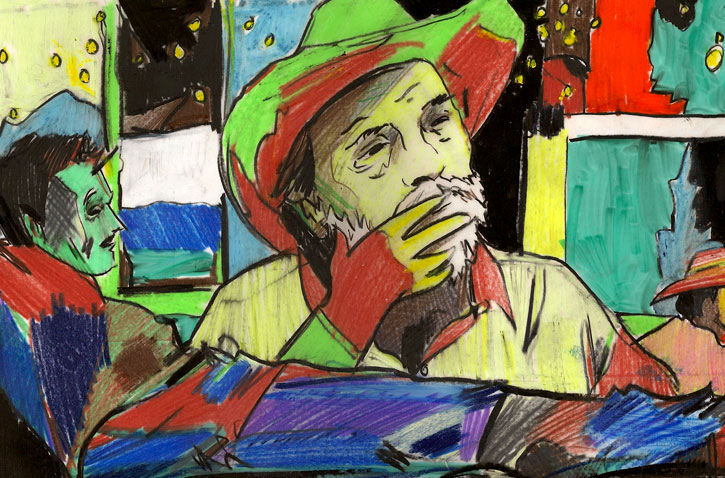
Our scene occurs in an underdeveloped little Mexican village where Mike must recover from a snakebite. Pete, meanwhile, unwinds in the Cantina Liebre awaiting a long-distance connection to his sometime girlfriend Rachel (Melissa Leo). He has a bit of a ‘shine on’, partly because he’s been sipping tequila and partly because, at this stage in his journey, exhausted, fixated on his role as captor, and closely acquainted with advanced bodily rot, he’s beginning to lose his mind. Surprisingly, his composure has never looked more serene. Maybe it’s the motley amalgamation of the mise-en-scène that meets with his wavelength. The advanced setting sun issues streaks of purple and orange; a Mexican girl keys Chopin on a creaky, out-of-tune piano; a dubbed fifties-era sci-fi film plays on a black and white TV; and strung through the cantina, pulling all the discordance together, is a charming string of Christmas lights. Further echoing Pete’s wavelength is the bizarre sound of a radio dial, channels fading in and out, as though his mind were an antenna tuning in to remote frequencies in tandem. Several characters have accused our protagonist of being crazy by now, and we have begun to worry if his apparent love of this ‘scene’ is testimony to that fact.
Next comes the phone call and Pete asks Rachel to leave her husband and come marry him in Mexico. She had previously told Pete she loved him, quite disingenuously, though Pete seems to have taken her at her word. Moments before, so at home in the cantina, he must have thought ‘If Rachel could only see this “scene” the way I do, she would get me, too’. Alas, she is bewildered: “Pete you don’t understand, I have to go.” He hangs up the phone and lurches out of the cantina, around the corner and into a little shed. He slowly unwraps the coverings from his only friend, the long rotten Melquiades. The stomach-churning fetor, to which others frequently bear witness, in no way registers on Pete’s face, however. He can only utter, “You look like hell, son,” as he proceeds to comb him with a horse brush, pulling the hair clean off his head with a dull scraping sound. Defeated, he slumps back against the shed wall, resigned to utter alienation.
This scene is what I take to be the film’s centrepiece, expressing the culmination of two contradictory impulses underlying the entire film: the romantic promise of the Western fable and the material denial of its possibility. The two come together here in an off-kilter, quasi-surreal composition, unhinging our confidence in the protagonist’s narrational authority. In the style of Pasolini, director Jones conveys a ‘free indirect discourse’, oscillating between the objective sounds in the cantina and the warped noise passing through Pete’s mindscape. This not only sets Pete apart, it forces us to appreciate the setting’s discordant elements as harmonised through Pete’s peculiar point of view. Equally important are the sundry odd details, such as Pete’s bowlegged walk and the limping bartender with the large hoop earring, because they draw attention to themselves, away from any propensity toward abstraction.
The primacy of concrete details and graphic imagery is a key feature of the late Western as a whole, which deviates from the Classical tradition. The Classical Western has a unique capacity to idealize a formative period in US history, aggrandizing the cowboy’s heroic feats, while fleshing out the mise-en-scène with enough historical minutia, sand, and grit as to make it all believable. Such is the crafty way the genre has succeeded in conflating myth with fact, instilling (particularly within American audiences) a mythological sense of history. This success, Douglas Pye argues, is achieved principally through a stylistic formula that balances romantic abstraction and concrete detail. Following Northrop Frye’s structuralist theory of myth, Pye interprets the Classical Western as a blend of the Romance narrative and low-mimetic manner (204, 209-15).
By contrast, the late Western genre eschews romanticism while further intensifying a low-mimetic style. Instead of superior masculine prototypes and quick-draw gunslingers, we watch ordinary men caught in dysfunctional relationships, struggling with guns that misfire (Unforgiven), villains that get away (No Country for Old Men), and heroes that shoot people in the back (Assassination of Jesse James). This effectively cracks the form’s glossy sheen of myth. Yet, in such a strongly coded genre as the Western, the romantic connotation may linger in the ether of the film’s diegesis, continually tugging at us as a noticeable absence. Three Burials, and the cantina scene especially, exploit this fractured visibility. Even as the signs of romantic abstraction are suppressed from our perspective, Pete restores this tendency by romanticizing the mise-en-scène’s jumble of imperfections into the ‘perfect scene’. While we can persist in being cynical about such romantic fables we can still identify with Pete, at least from a certain remove, as being one of more than a few Americans past middle age whose masculinity has been largely shaped through icons of Western performance.
So, too, is there the sense that we are ‘seeing’ two sensibilities at once, strictly on the level of cinematography. This ostensibly provides the viewer a ‘thwarted fable’ of the kind Jacques Rancière explicates in Film Fables. For Rancière, the camera’s impassive recording of materiality is predisposed to thwart the fable-the storytelling function aimed towards a consciously determined end-by persistently drawing attention to the thingliness within the image. He writes: “A constant principle of [mise-en-scène] is to supplement-and thwart-narrative continuity and the rationality of the goals by not aligning two visibilities” (16). Rancière proceeds to demonstrate that this can take place in an infinite number of ways, among all the genres of experimental, documentary, and narrative cinema; but in each instance the film fable is a thwarted fable, aesthetically enriched through its disjunctive synthesis of noumenal materiality and fictional pretence, of truth and lies.
Rancière’s choice of the word fable is especially appropriate here because it connotes a story secured in a simplified moral universe, an otherwise tall tale requiring the extension of belief. We might consider the Classical Western text as just such a fable, that which in our present era has become a bygone model that once asserted our trust in the stability of ethical values and America’s foundational spirit. For the purpose of this analysis, we might also consider the similar term myth in keeping with Richard Slotkin’s ‘Frontier Myth’ formulation, as the root symbolic narrative ubiquitous in American film and literature (Western genre and otherwise). More specifically, Slotkin’s Frontier Myth represents “the redemption of American spirit or fortune as something to be achieved by playing through a scenario of separation, temporary regression to a more primitive or ‘natural’ state, and regeneration through violence” (12). The fable then, is the outworn fiction, cut off from its source in consensual belief, whereas the myth is the condensation of those operant ideologies, still insidiously buried within the text’s substructure.
Qualifying these terms this way, the Post-Mortem Western emerges as a distinct form of thwarted fable, one that resurrects the spectre of the Classical Western text only to quash it through its diegetic immersion in postmodernity. The old fable is called to the fore connotatively, through horse and cowboy iconography, but the mise-en-scène insists upon its own present-day-ness. Images of modernization and post-industrial banality cause a perceptual incongruence-helicopters patrolling the canyon while Pete rides horseback into Mexico ruin the portrait’s idyllic harmony. As opposed to the cohesion maintained in Pye’s model of the Classical Western, a double vision of two competing iconographies ensues, continually pushing the fable back into an irrecoverable past. In the same way, the cantina scene’s split-subjectivity puts us at a remove from Pete as the fable’s sole exponent. This has a double and concurrent effect: the fable betrays not only how conspicuously out of joint it is with public perception, but also how stubbornly entrenched it is within American identity. The Western’s root language has bonded to an aspect of American Exceptionalism that apprehends the West as a long-established regenerative fount. The frontier, for example, simultaneously spells escape from a spoiled society and purification of the soul through a ritual of violence. Just as it serves as a prescription for masculine subject formation, the ‘way of the West’ is also the ancestral path towards restoring America’s democratic values and institutions.
Of course, the absence of an actual frontier begets a cultural desire to recreate one mythically, in America’s outlying parched landscapes, in rural Mexico, in post-Apocalyptic scenarios, in outer space, or even in the liminal reaches of the mind, where the floodgates of thought avail to a sea of instinctual primitivism. On the deep mythic level, this communion with the raw and barbaric, either from without or within, delivers salvation. The Frontier Myth lurks beneath the surface, structuring narrative logic that at once summons our allegiance and insults our intelligence. The perpetual cycles of the genre’s death and rebirth and the multitude of quasi-Western incarnations clearly have something to do with this myth’s power, both awesome and crude. Our scene expresses this alternating fascination as a disjunctive juxtaposition, not only in the duality of visibilities but also in the spatial contrast between the cantina and the shed. The former, colourfully glamourized through Pete’s point of view, sets up the promise of life-long happiness with Rachel. Whereas the latter, squalid and metallic, speaks the truth of Pete’s deranged condition-he has no one to confide in but a corpse. Melquiades’s unsightly remains represent the Western fable’s present condition, what is long dead and what Pete, against all odds, endeavours tirelessly to resurrect. Just how many times will the Western be pronounced ‘dead’ and then resurrected once again, anyway? Surely the zombie-Western hybrid is not far off…
Continuing with the film’s self-conscious fabular structure, it is curious that we never see Pete and Melquiades interact but through Pete’s many flashbacks. From the outset, the film is in the habit of looking back to a time when all that was golden, vital, and praiseworthy revolved around the figure of Melquiades. One such day, Pete vowed that if Melquiades should die, he would bury him in Mexico and not in Texas, “beneath all the fucking billboards.” To fulfil his pledge, Pete becomes the righteous outlaw: enacting vigilante justice on the killer, kidnapping, grave robbing, and stealing into Mexico with the police and border patrol in close pursuit. The Western fable dictates such courage, to risk one’s life and social acceptance in order to ‘do what a man’s gotta do’; to honour the homosocial bond here consummates the masculine ideal. There is a catch, however, as we learn that Melquiades never actually had a wife, nor is there any village called Jimenez-either Melquiades lied or Pete remembered incorrectly. But Pete refuses to believe this. He obstinately roams the outback in search of the mythical Jimenez until he comes across some old ruins that he convinces himself is the place, so he can bury the body and keep the fabular logic intact.
Pete’s nostalgia for a better time mirrors the Western’s nostalgia for a post-bellum America, before late 19th century modernity significantly restructured men’s lives in the public and private sphere. From this early point in its history, the Western provided a mythic escape for men through homosocial narratives of male bonding which, as literary critic Jane Tompkins argues, freed them from the clutches of women and religion (47-67). Both Tompkins and sociologist Michael S. Kimmel consider the Classical Western as an anti-feminist reaction to the 19th century’s ‘feminization of culture’, a reaction born of masculinist impulses to police boundaries between the sexes by gendering value-laden domains (Kimmel 21). According to the Western, the woman’s world is the home, the school, and the church, while the man’s is the frontier, the saloon, and the savage war. Because the cowboy is severed from the world of education, words, and emotions, he has stamped out his inner life, as Tompkins alleges, resulting in a hard-bitten taciturnity. This pitiable disconnection is perhaps best expressed in the way Pete’s unending devotion to the homosocial bond forgoes heterosexual partnership in favour of nestling a male corpse bride. For all the romantic splendour conferred upon the figure of Melquiades, the mortal thingliness of his corpse never ceases to remind us of the brutal truth; Pete enjoins us to make love to the fable despite its peeling flesh. Above all, the scene is an elegiac lament for the cowboy’s lonesomeness-in the way the mise-en-scène turns from twinkling luminescence to glum alienation, in the way Rachel turns him down flat and he seems rather unsurprised, in the way nobody alive understands him. The cost for his principles is absolute, depriving him of everything but his resolve.
But is it worth it? The aforementioned tensions culminate here to force the question, one that the film does well to sustain without an easy answer-because Melquiades’s shooting was an accident and not born of malevolent intent; because one’s place of burial is, at bottom, an issue for the worms; because there is no real Jimenez and no grieving wife; because Pete’s actions border on the megalomaniacal; because living in a society means living in an imperfect world. For all of these reasons, which are made abundantly clear to the viewer, the fable is stripped of its utopian connotations and lodged as an insular principle in Pete’s mind. The only justification remaining is that ‘the Norton boy’s gotta be taught a lesson’.
In this respect, the film puts forward an argument embracing the Frontier Myth as necessary for an ethical and exemplary masculinity. Pete Perkins, leather-faced cowboy that he is, seems to have already been through the ritual of separation, regression, and violent regeneration that the Frontier Myth prescribes. He therefore serves as the older, wiser mentor needed for Mike’s moral tutelage. Mike, smarmy and aggressively domineering, exhibits a compulsive masculinity. Kimmel perceives the common characteristics of “violence, aggression, extreme competitiveness, [and] a gnawing insecurity” as the defining features of a compulsive masculinity, “a masculinity that must always prove itself and that is always in doubt” (93). Mike Norton constantly tries to prove his manliness by beating illegal immigrants and by ‘plowing’ his ‘baby-doll’ wife (January Jones) in short, loveless spurts. As Pete succeeds in breaking Mike’s arrogance and humbling his spirit, the film recuperates the cowboy as a noble knight-errant. By the end, even Mike begins to come around to Pete’s point of view. The final shot of Pete riding away with Mike, the pupil, calling out after him, replays the fabular ending as seen in Shane (George Stevens, 1953), Pale Rider (Clint Eastwood, 1985), and Dances With Wolves. Even though Three Burials casts the fable in a doubtful, regressive light, it redeems an ethical education from the underlying Frontier Myth. And yet, enacting the Frontier Myth’s scenario in and of itself requires a compulsive masculinity, which is a premise that the film critiques in a more oblique way.
Though virtue distinguishes him from Mike, Pete’s masculinity is also compulsive. Although, the film’s taut balance between identification and alienation makes that fact difficult to discern. As mentioned, the many instances of singling him out as ‘duped’-by characters who call him crazy, by his refusal to believe otherwise about Melquiades’s story, by his glazed expression now and again-reinforce our prejudices of the fable’s unpopular standing and alienate us from the protagonist. Despite these alienating conventions, however, the film’s form ensures that we identify with Pete. It obviously helps that, as a rule, outcast heroes draw our sympathy, a convention that is all the more vital to what makes the Western tick; but also the range of narration is closely restricted to Pete’s point of view, depicting him as the only mindful and caring soul at odds with an apathetic community. This, compounded with how our sensibility is aligned with his through the emotional colouring of the mise-en-scène and non-diegetic music, constantly counters the alienating effect. Consequently, we know why people call him crazy, but we probably don’t believe them on a gut level; while we watch him losing his mind, his firmness of purpose still wins our trust.
Indeed, we may hardly notice how we are gradually induced into Pete’s emotive brand of ethics and righteous indignation, how we begin to abide his kidnapping, his disinterment of a dead body, his willingness to shoot Mike, and his intractable need to fulfil his quest. Even so, at some point we begin to see that he has gone too far and we have been enthralled and won over by a compulsive masculinity. The degree to which we fail to recognize being carried along in this way reveals the degree to which the Frontier Myth still has its hooks in us, the degree to which we still find something worthy and redeemable in its influence on masculine subject formation. Perhaps the sharpest hook is our belief that violence in the hands of a competent and seasoned masculinity is not only tolerable, but necessary.
This brings us back to our scene, which we can examine one last time on the level of performance. We watch Pete Perkins drinking in the cantina, obdurate and weathered like an old stone shaped by nature’s attrition. Life can set upon him little that is new. The depth of his eyes, registering a well of tenderness behind a wary countenance, never ceases to reel us in and cast us out again as we guard against his next defiance. There is something about his masculinity that is tragically familiar, the way one’s armour and compassion can be worked over by circumstance. What will ail this parched Fisher King, we wonder, this forlorn cowboy with his bottomless wound? For now it seems to be something in the uncanny atmosphere of the place, the lurid living skies, the soft electric lights, and the young girl plunking a sentimental piece of Chopin. The scene’s many cracks and imperfections faintly mirror Pete’s brokenness. Indeed, it is rather strange and wonderful how this warms Pete, as he smiles bemusedly to himself; amidst the decomposing debris of the Western, he seems at peace for the first time since Melquiades’s death.
Such is the way masculinities can be understood and absorbed through direct performative transmission: through bodies, eyes, and mouths. The poetic mix of pain and beauty is the scene’s wellspring reverberating outward through the many levels of ambivalence. In the 1970s, theatre critic Eric Bentley commented on the powerful influence John Wayne’s bodily performance had on subject formation and the political during the Cold War era. In the case of Wayne, whose pugnacious machismo Bentley saw as the essence of Anti-Communism, the body became the body politic (308). A similar thing can be said of Tommy Lee Jones, whose unique combination of iron and rust, stone and feeling, stands for the strong emotions-and less certain thoughts-that we have nowadays about cowboy masculinities. Lest we take its small-scale of late as an indication of the Western’s outmodedness, to be sure, the cowboy body politic is alive and well. Just as the world and a divided America watched its last cowboy president wield a compulsively masculine foreign policy through a two-term presidency, we are continually astonished to see culture making vintage from this gnarled and bitter fruit. Surely Three Burials, with its left-leaning sensibilities, makes no apologies for George W. Bush, but it certainly sits amongst a cycle of films that can partly explain the muddled thinking and feeling that elected him to office.
Despite my attempts to clarify how Three Burials plays with and against convention, warping and weaving generic processes, the film would rather tangle it all up and leave us with a confused knot in our stomach. It genuinely tries to recuperate America’s knight-errant while simultaneously alluding to the masculinist, compulsive trappings afoot in the genre’s formative heritage. But above all else it reflects the love-hate relationship America and the rest of the world have with the cowboy. Pete represents an undying affection for what everyone else sees as gone to rot. It’s not rot, the contemporary Western insists, but refined ferment. The juices of the Frontier Myth having long since reacted with the counter-culture climate, have boiled away the mustiness and distilled a potent new tonic. Three Burials proves most viscerally how we remain galvanized by Post-Mortem genres, ever watchful for the moment when the corpse starts to turn.

Works Cited
Bentley, Eric. “The Political Theatre of John Wayne.” Theatre of War: Comments on 32 Occasions. New York: Viking Press, 1972. 306-312.
Box Office Mojo. 1 Nov. 2006. 12 June 2009. <http://www.boxofficemojo.com/movies/?page=intl&id=3burialsofmelquiadesestrada.htm>.
Comolli, Jean-Louis, and Jean Narboni. “Cinema/Ideology/Criticism.” Film Theory and Criticism. Eds. Gerald Mast et al. Fourth Ed. New York: Oxford University Press, 1992. 682-689.
Durgnat, Raymond, and Scott Simmon. “Six Creeds That Won the West.” Film Comment Sept.-Oct. (1980). Reprinted in The Western Reader. Eds. Jim Kitses and Greg Rickman. New York: Limelight Editions, 1998. 69-84.
French, Philip. Westerns. London: Secker and Warburg, 1973.
Gallafent, Edward. “Not with a Bang: The End of the West in Lonely are the Brave, The Misfits, and Hud.” The Book of Westerns. Eds. Ian Cameron and Douglas Pye. New York: Continuum Publishing, 1996. 241-254.
Kimmel, Michael S. The History of Men: Essays in the History of American and British Masculinities. New York: Suny Press, 2005.
Kitses, Jim. “Authorship and Genre: Notes on the Western.” Horizons West: Anthony Mann, Budd Boetticher, Sam Peckinpah: Studies of Authorship Within the Western. Bloomington: Indiana University Press, 1969. Rpt. in The Western Reader. Eds. Jim Kitses and Greg Rickman. New York: Limelight Editions, 1998. 57-68.
Pye, Douglas. “The Western (Genre and Movies).” Film Genre Reader III. Ed. Barry Keith Grant. Austin: University of Texas Press, 2003. 203-218.
Rancière, Jacques. Film Fables. Trans. Emiliano Battista. New York: Berg, 2006.
Slotkin, Richard. Gunfighter Nation: The Myth of the Frontier in Twentieth Century America. New York: HarperCollins, 1992.
Tompkins, Jane. West of Everything: The Inner Life of Westerns. New York: Oxford University Press, 1992.
Wright, Will. Six Guns and Society: A Structural Study of the Western. Berkeley: University of California Press, 1975.

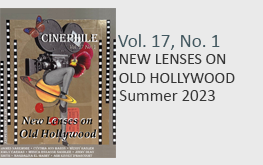
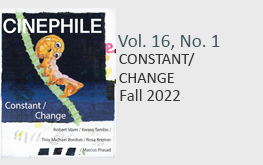
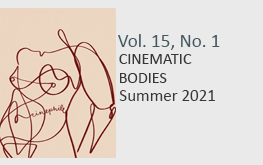
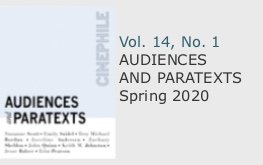
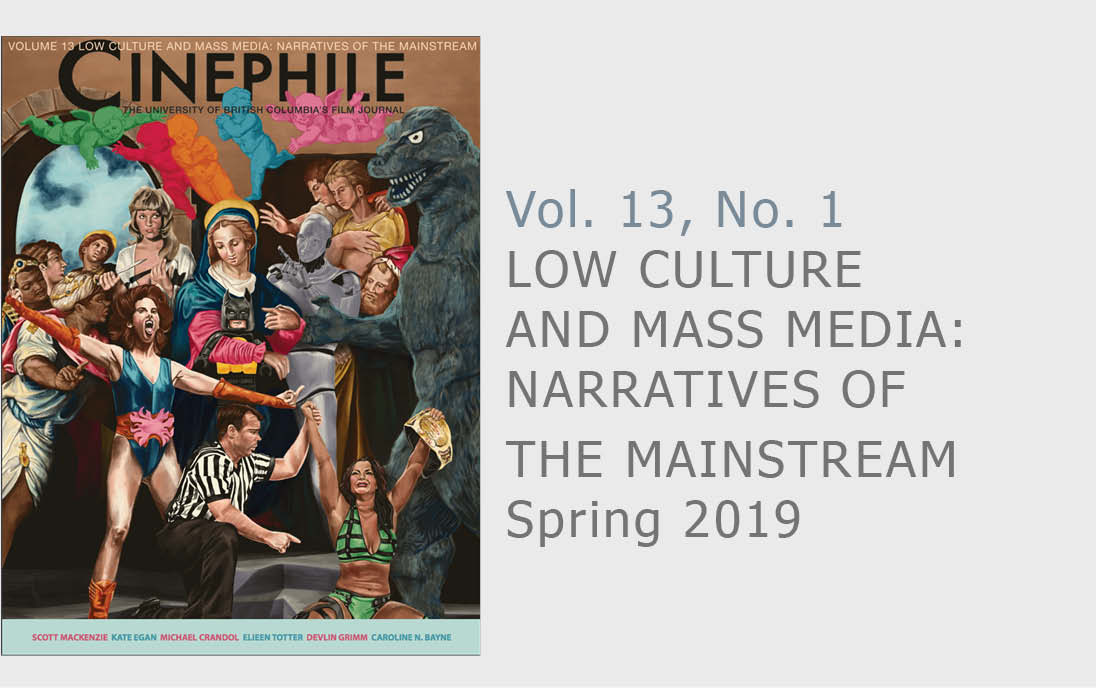
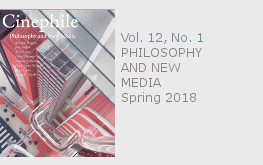
Great sharing. I’m subscribing to your site now. Thanks 🙂